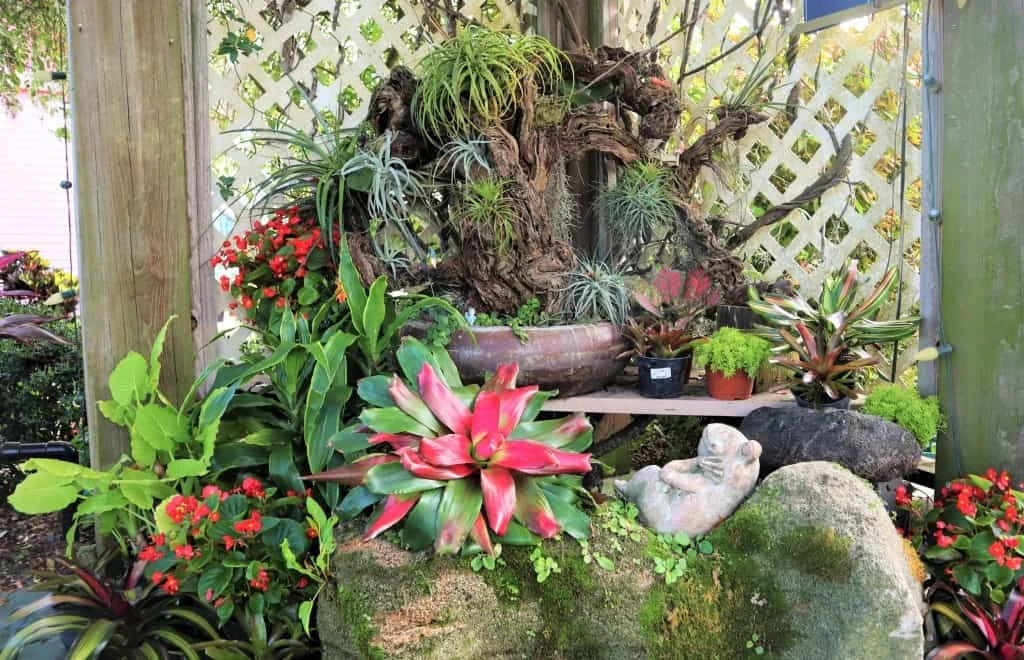by Amanda Rose Newton
Bromeliads are easy-to-grow, low maintenance plants that give off instant tropical flair and can be grown indoors and out, in trees or in the ground.
Worldwide, there are over 2,500 species with diversity ranging from the familiar native Spanish moss to the edible pineapple. With so many interesting variations to choose from, it is no wonder some of us are bromeliad-crazy! With many blooming plants about to fizzle out in the intense summer heat, picking up a few bromeliads for the landscape is an easy way to infuse a burst of color to carry through the season.

Decisions, Decisions!
Just about every variety will flourish in the humid environment offered by Florida and will even thrive in shade. While they love moisture from humidity, they are also fairly drought tolerant. No yard? No problem! Bromeliads are just as easy to do in containers both indoors and outdoors. They can also grow successfully as epiphytes, or air plants, where their roots come in handy as support.
Getting to Know Your Bromeliad
If you are new to the world of bromeliads, they can come off a little alien. With their spikey foliage, tendency to live in trees, offspring that spawns directly off their bodies, and the weird central cup they have that stores water, they certainly are in a class by themselves! The latter is due to the overlapping leaves and serves as a handy gauge for when it is time to water. There should always be water present in the cup, so when it is low or empty, go ahead and top it off. As a rule, spikey-leaved bromeliads need less water than their softer-leaved kin.
Planting your Bromeliad
If you are going the potting route, be sure to choose a medium that is well-drained. Adding in perlite or pine bark nuggets can also enhance their drainage potential. Bromeliads have shallow root systems, so no need for planting deeply. If you are growing yours outdoors, select a shady spot (underneath trees are a great location) that drains well. Growing indoors? They perform best near a window or anywhere that includes diffused light. Remember, bromeliads are not fussy! Watering just once every week or two should be adequate. If it looks like temperatures might take a significant plunge, make sure to protect your outdoor plants, or better yet, bring them inside as few species are cold hardy.
Best Buds
The one downside to bromeliads is that they give you a beautiful flower, but only once! Soon afterward, the plant will die. Luckily, the flower is so amazing and long-lasting that it is worth it! Once they have flowered, you will notice little “offsets” which are affectionately referred to as “pups” that are clones of the mother plant. Once they are about half the mother’s size, you can remove those and replant them with a little rooting hormone, giving you a whole new plant to enjoy. The mother plant will continue to put out more offshoots throughout the remainder of its lifespan. Need a visual on how best to separate new pups? Check out our dividing and repotting bromeliads video starring our Indoor Plant Expert, Kim!
Bromeliad Pests and Disease
As rough and tough as bromeliads are, they are still susceptible to the occasional pest. Pests that tend to plague other house and landscape plants, such as scale, are easy to treat with an oil or soap-based treatment. We suggest All Seasons Horticultural Oil or Insecticidal Soap. Fungi can happen, although rare, and is usually due to not allowing adequate space between plants or allowing too much moisture to accumulate. Those keeping their bromeliads outdoors might end up with small frogs living in the water-catching cups, which serves as natural bug control!
To Feed or Not to Feed?
Fertilizing is a divided topic among bromeliad enthusiasts. For the most part, those planted outdoors should be successful without the addition of any fertilizer. For indoor bromeliads, you can safely use a water-soluble fertilizer such as Jack’s Classic 20-20-20 mixed at a quarter of the recommended strength. After applying, flush out the water cup to prevent burning delicate leaves. Applying during the cool evening or morning hours is best.
Here at the garden, it is not unusual for us to stock 30 different varieties of bromeliads at a time, so be sure to check our inventory regularly and stop in. Check out our selection of bromeliads here.


